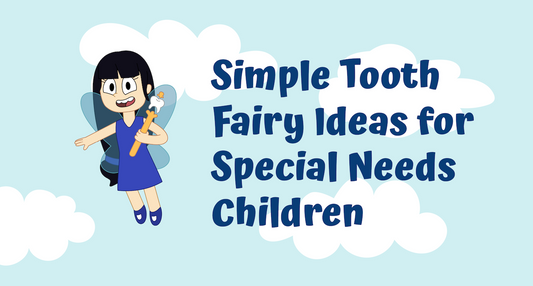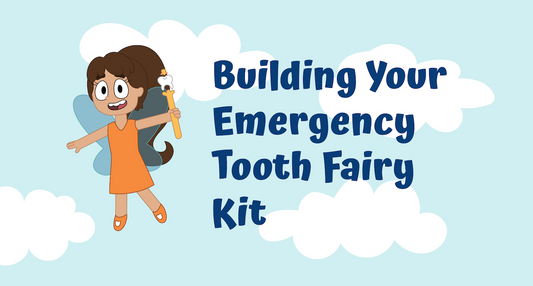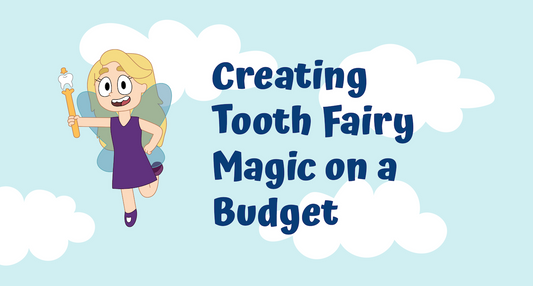Navigating the tooth fairy tradition becomes significantly more complex when you have multiple children at different stages of tooth loss. From managing jealousy over varying gift amounts to handling the logistics of multiple loose teeth, parents with siblings face unique challenges that can turn magical moments into family drama. This comprehensive guide helps you create fair, meaningful tooth fairy experiences for all your children while maintaining the wonder and excitement of this cherished childhood tradition.
Understanding the Sibling Dynamics of Tooth Loss
When multiple children are losing teeth, several factors can create tension and disappointment:
Age Gap Challenges: Children of different ages have varying developmental needs, expectations, and understanding of fairness. A 6-year-old losing their first tooth has different needs than a 10-year-old losing their final molars.
Timing Conflicts: Murphy's Law seems to apply to tooth loss—siblings often lose teeth simultaneously or during inconvenient times, creating logistical challenges for parents trying to maintain individual magic.
Comparison Culture: Children naturally compare their experiences with their siblings, leading to questions about why one child received more money, a different gift, or seemingly more attention during their tooth fairy visit.
Memory Inconsistencies: Older children may remember different tooth fairy traditions or gifts from their earlier tooth losses, creating expectations that may not align with current family circumstances.
Creating Fair Yet Individual Tooth Fairy Experiences
The key to managing sibling tooth fairy dynamics lies in balancing fairness with individuality:
Establish Clear Family Tooth Fairy Policies
Create consistent guidelines that apply to all children while allowing for appropriate variations:
Standardized Base Rewards: Establish a standard tooth fairy rate that applies to all children, adjusted for inflation or family circumstances if needed. This prevents the "why did she get more?" conversations that can derail the magic.
Special Occasion Premiums: Clearly define when extra gifts or money are appropriate (first tooth, last baby tooth, especially brave behavior during a dental procedure) so all children understand these aren't arbitrary decisions.
Age-Appropriate Variations: Older children might receive slightly different gifts that match their maturity level, such as books or small items they can use, while younger children receive more traditional offerings.
Individualized Magic Within Consistent Framework
While maintaining fairness, create unique touches for each child:
Personalized Fairy Notes: Each child should receive notes that acknowledge their specific personality, interests, or recent achievements. These personalized fairy communications make each child feel specially recognized.
Character Assignments: If using the Hi Tooth Fairy world, assign each child a specific fairy friend (Birdie, Frankie, Lulu, Piper, Tulip, or Winnie) who "specializes" in their teeth. This creates individual relationships while maintaining the larger magical framework.
Customized Celebration Styles: Tailor celebration approaches to each child's personality—some children love elaborate productions while others prefer quieter, simpler acknowledgments.
Managing Simultaneous Tooth Loss Events
When multiple children lose teeth close together, strategic planning prevents chaos:
The "Tooth Fairy Traffic" Explanation
Create a logical explanation for why the tooth fairy might handle simultaneous visits differently: "The tooth fairy has to visit so many children when multiple teeth come out in one house! Sometimes she makes multiple trips, and sometimes she brings helper fairies to make sure everyone gets the attention they deserve."
Staggered Magic Timing
Consider having the tooth fairy visit children on different nights, even if teeth were lost simultaneously:
- Child A loses tooth Monday, gets visit Monday night
- Child B loses tooth Tuesday, gets visit Wednesday night
- This prevents direct comparison and gives each child their individual moment
Collaborative Celebrations
Turn simultaneous tooth loss into a special family event:
- Create a "tooth fairy party" where both children are celebrated together
- Have the tooth fairy leave a joint note congratulating both children
- Design special activities that both can enjoy regardless of their individual gifts
Handling the "Fairness" Conversations
Despite your best efforts, children will notice differences and voice concerns about fairness:
Age-Appropriate Explanations
For Younger Children (Ages 4-7): "The tooth fairy knows exactly what each child needs and likes. She's very smart about giving just the right gift to each person."
For Older Children (Ages 8-12): "Different families have different tooth fairy traditions, and even within families, the tooth fairy might give different gifts based on what she thinks each child would enjoy most."
Emphasizing Individual Value
Help children understand that fairness doesn't always mean identical treatment: "The tooth fairy doesn't just count teeth—she thinks about each child as a special person with their own interests and personality."
Redirecting Focus to Growth
When children complain about differences, redirect the conversation to the meaningful aspects: "What's most exciting about losing this tooth? How does it feel to be growing up?"
Creating Positive Sibling Dynamics Around Tooth Loss
Transform potential jealousy into supportive family traditions:
Sibling Support Roles
Older Children as Tooth Fairy Helpers: Once older children outgrow the tooth fairy belief, invite them to become "magic keepers" who help create special experiences for younger siblings.
Celebration Assistants: Encourage siblings to help celebrate each other's tooth loss milestones, creating a family culture of mutual support and excitement.
Memory Makers: Older children can help document younger siblings' tooth fairy experiences through photos, drawings, or special notes, contributing to the family's tooth fairy memory collection.
Family Tooth Fairy Traditions
Tooth Fairy Family Journal: Create a family journal where each child's tooth fairy experiences are documented together, showing how the tradition connects all family members.
Sibling Tooth Fairy Advice: Encourage older children to share "wisdom" about tooth care and tooth fairy visits with younger siblings, creating mentorship opportunities.
Group Tooth Fairy Projects: Collaborate on family projects like creating a tooth fairy door, garden, or special tooth storage containers that all children can enjoy.
Managing Different Developmental Stages
When siblings are at vastly different developmental stages, tailor your approach accordingly:
The Believer and the Skeptic
Protecting the Magic: When one child still believes while another is questioning or has stopped believing, create separate conversation spaces and enlist the older child's help in preserving magic for younger siblings.
Transitional Strategies: Help older children transition from belief to participation by emphasizing their important role in creating joy for younger family members.
Mixed-Age Logistics
Bedtime Coordination: Stagger bedtimes or tooth fairy visits to ensure each child gets individual attention and magic.
Gift Appropriateness: Ensure gifts are age-appropriate and won't create safety concerns when younger siblings are present.
Special Circumstances and Solutions
The Competitive Child
Some children naturally compare everything with their siblings:
Focus on Personal Growth: Emphasize each child's individual tooth loss journey rather than comparing experiences between siblings.
Unique Tracking Systems: Create individual tooth tracking charts that celebrate each child's progress without direct comparison.
The Anxious Child
When one child is nervous about losing teeth while siblings are excited:
Individualized Comfort: Provide extra reassurance and perhaps special comfort items from the tooth fairy for anxious children.
Sibling Mentorship: Encourage confident siblings to share positive experiences and offer support.
The Late Bloomer
When one child loses teeth much later than siblings:
Patience and Reassurance: Emphasize that everyone develops at their own pace and the tooth fairy will be just as excited whenever their teeth are ready.
Alternative Celebrations: Create interim celebrations for loose teeth or dental check-ups to maintain inclusion.
Long-Term Strategies for Sibling Harmony
Building Family Tooth Fairy Legacy
Multi-Generational Stories: Share stories about your own childhood tooth fairy experiences and those of relatives, showing how the tradition connects generations.
Family Tooth Fairy Values: Establish clear family values around the tooth fairy tradition that emphasize kindness, growth, and mutual support rather than competition.
Preparing for Transition Periods
Gradual Shifts: As children age out of the tradition, gradually shift focus from individual magical experiences to family traditions that include everyone.
Memory Preservation: Create lasting memories through photo albums, journals, or special keepsakes that all children can appreciate as they grow older.
Conclusion: Creating Harmony in the Chaos
Managing tooth fairy traditions with multiple children requires planning, flexibility, and creativity, but the rewards are immeasurable. By establishing fair yet individualized approaches, fostering sibling support, and focusing on the deeper meaning of celebrating growth and development, you can transform potential drama into cherished family memories.
Remember that perfection isn't the goal—connection is. Even when things don't go exactly as planned, the love and attention you put into creating magical moments for each child will be what they remember most.
The tooth fairy tradition offers a unique opportunity to teach children about fairness, individual differences, and family support. By approaching sibling dynamics thoughtfully, you're not just managing tooth fairy logistics—you're building family bonds that will last long after the final baby tooth falls out.
Want to make managing multiple children's tooth fairy experiences easier? The Hi Tooth Fairy app allows each child to have individual conversations with their favorite fairy friend, creating personalized experiences that reduce sibling comparison while maintaining the magic for everyone.




